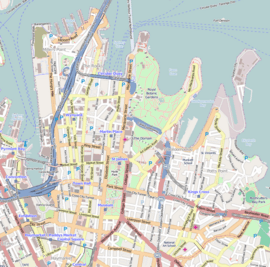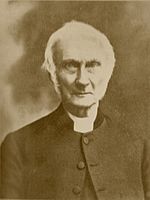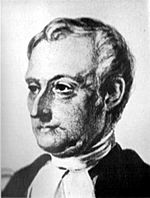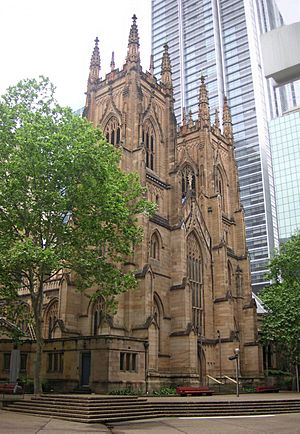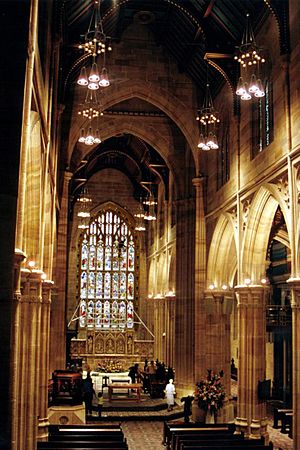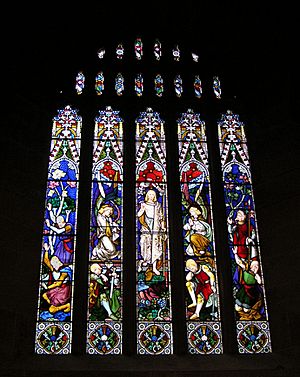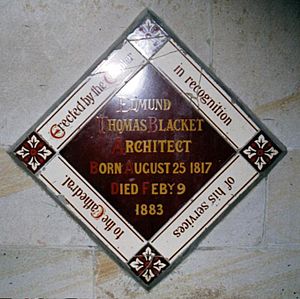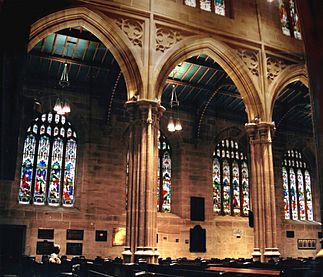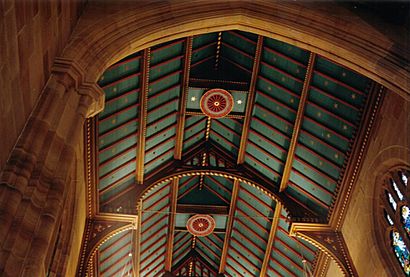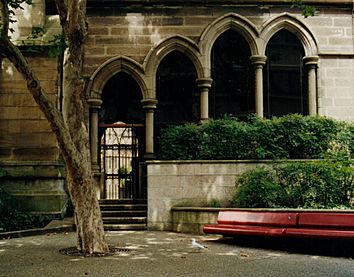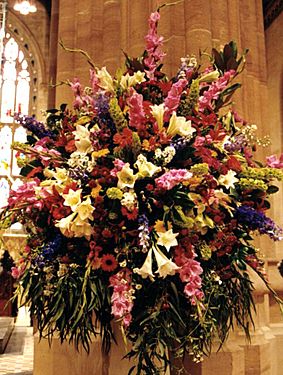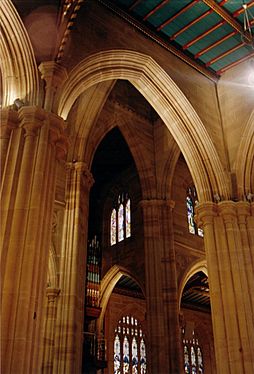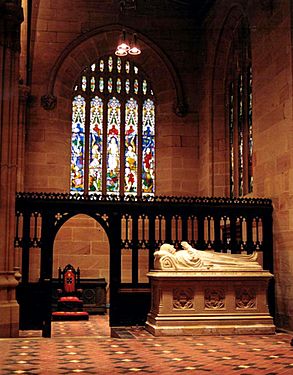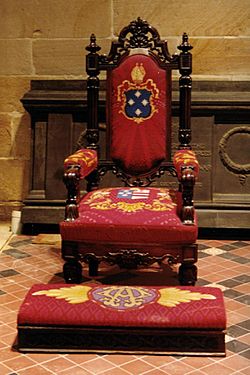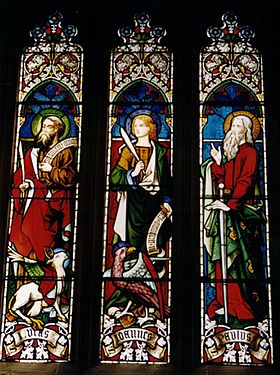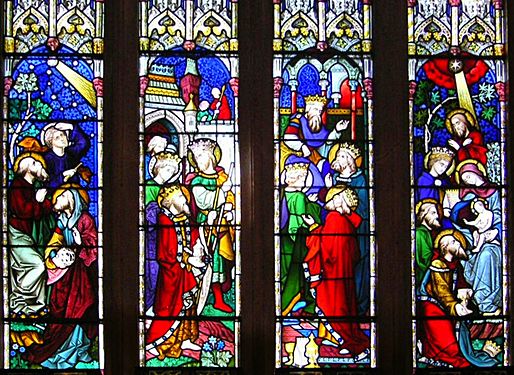St Andrew's Cathedral, Sydney facts for kids
Quick facts for kids St Andrew's Cathedral, Sydney |
|
|---|---|
| Cathedral Church of Andrew the Apostle | |
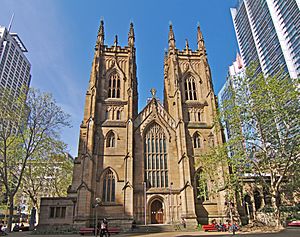
West front
|
|
| 33°52′26″S 151°12′23″E / 33.873923°S 151.206336°E | |
| Location | George Street, Sydney CBD, New South Wales |
| Country | Australia |
| Denomination | Anglican |
| Churchmanship | Low church evangelical |
| Website | sydneycathedral.com |
| Architecture | |
| Architect(s) | Edmund Blacket |
| Architectural type | Cathedral |
| Style | Gothic Revival |
| Groundbreaking | 1837 |
| Completed | 1868 |
| Specifications | |
| Length | 48 metres (157 ft) |
| Width | 17.6 metres (58 ft) |
| Width across transepts | 33.3 metres (109 ft) |
| Height | 29.7 metres (97 ft) |
| Tower height | 40 metres (130 ft) |
| Administration | |
| Diocese | Sydney |
| Province | New South Wales |
St Andrew's Cathedral (also known as St Andrew's Anglican Cathedral) is a cathedral church of the Anglican Diocese of Sydney in the Anglican Church of Australia. The cathedral is the seat of the Anglican Archbishop of Sydney and Metropolitan of New South Wales (currently the Most Reverend Kanishka Raffel from 28 May 2021). The position of Dean of Sydney has been held by the Very Reverend Sandy Grant since 9 December 2021.
The St Andrew's has an Evangelical ministry, holding services every day, including a weekly healing service. There is a cathedral choir of men and boys who sing during term time, as well as a company of bell ringers. The notable pipe organ has been restored and is regularly used for recitals and concerts.
Designed primarily by Edmund Blacket on foundations laid by James Hume, the cathedral was built from 1837 to 1868, and was ready for services and consecrated in 1868, making it the oldest cathedral in Australia.
St Andrew's is one of the city's finest examples of Gothic Revival architecture. Joan Kerr described the cathedral as "a perfect example of the colonial desire to reproduce England in Australia in the mid nineteenth century".
The cathedral is located at 1400 George Street in the Sydney central business district of the City of Sydney local government area of New South Wales. St Andrew's is owned by the Anglican Church Property Trust. It was added to the New South Wales State Heritage Register on 3 September 2004; is listed on the City of Sydney local government heritage register; and is listed on the (now defunct) Register of the National Estate.
Contents
Building and architecture
Macquarie and Greenway
Lachlan Macquarie, an early Governor of New South Wales, had grand plans for the city of Sydney. He foresaw that Sydney would grow into a large city requiring a large cathedral. With the architect Francis Greenway, who had been transported to Sydney for forgery, the governor planned a church 200 feet square and probably with the seating and galleries facing inward from three sides. The foundation stone was laid with full ceremony on 31 August 1819. Only a few foundations were laid, however, before the plan was abandoned. Macquarie was severely criticised for planning beyond the colony's means.
Broughton and Hume
Bishop William Grant Broughton, who was consecrated as a bishop in 1836, had a new foundation stone laid in 1837. The plans, prepared by the architect James Hume, were of much more modest proportions and were for a traditional cruciform church in the Gothic style. The designs, dating from the early phase of Gothic Revival architecture, did not show a great expertise in the handling of the particular architectural vocabulary. Only one notable section was completed, the façade of the south transept. However, the foundations were laid and some of the walls were constructed up to a height of about 15 feet.
Edmund T. Blacket
In 1842 Edmund Thomas Blacket presented himself to the bishop with a letter from the Archbishop of Canterbury recommending his talent as an architect and having equal facility in both the Classical and the Gothic style. He was eventually to become known as the Wren of Sydney, having designed two universities, three cathedrals and fifty or more parish churches as well as banks, offices, bridges, mansions and countless shops, cottages and terraced houses. Blacket became the official Colonial Architect from 1849 to 1854.
Blacket was an inventive and stylish Gothic Revival architect who utilised the forms of English Medieval prototypes reproduced in the books of his architectural library to produce designs which, although archeologically "correct", are often highly original. This was just as well, because the task that he inherited from James Hume was not an easy one. It took some convincing to get the bishop to accept his deviations from the original design. The problem was how to make a truly splendid and imposing cathedral on foundations which were only the size of a large English parish church. Taking into account what Hume had done and the fact that some of Hume's rather amateurish window tracery was already in place, Blacket designed the cathedral in the style known as Perpendicular Gothic, used extensively at the cathedrals of Canterbury, Winchester and York.
Perpendicular style
With the repetition of forms and the strongly vertical lines characteristic of Perpendicular Gothic, Blacket succeeded in creating a building which, despite its small size, is nevertheless imposing and of harmonious proportions. The western front with its layered decoration is a majestic composition, based loosely on that of York Minster. The strongly projecting rectangular buttresses, which transform by stages into lofty octagonally-sectioned pinnacles, and the complex molding around the portals casts varied shadows in the bright Australian sunlight. Kinsela describes it as “a grand façade with superb towers…Covered with a profusion of ornanament, blind traceries and tiny attached pinnacles, in a light-hearted yet elegant manner.”
Bishop Broughton did not live to consecrate St Andrew's. He died while on a trip to England in 1853 and is buried in Canterbury Cathedral. The second Bishop of Sydney, Frederick Barker, consecrated the completed building on St Andrew's Day, 30 November 1868.
Interior
The interior is a harmonious composition in Perpendicular Gothic. Although the building is small, it is given a sense of grandeur by the proportions of the arcade and clerestory, the richness of the moldings, the loftiness of the hammerbeam roof with its blue and vermillion decoration, and the decorative details, which include carved stone ribbons around the nave piers, bearing the names of notables in the early Sydney church. The stone used throughout is Sydney sandstone. The chancel has a newly restored floor in ornate pattern set with marble and intaglio tiles in the Cosmati style by Fields of London, created under the direction of Gilbert Scott. The rest of the building is paved with encaustic tiles of red and black with small intaglio designs by Mintons of Stoke-on-Trent.
The reredos was commissioned by the third Bishop of Sydney, Bishop Barry, and carved of translucent cream English alabaster by the sculptor Thomas Earp, under the supervision of the well-known Gothic Revival architect J. L. Pearson in 1886. The subject matter of the three pictorial panels, as originally created, were: at the centre, the Crucifixion; to the left, the Resurrection; to the right, the Ascension. To either side were the figures of Moses and Elijah. In 1887 there was objection at synod to the representational nature of the reredos and in particular to the central Crucifixion on the grounds that it might be seen as idolatorous. The Crucifixion was replaced, at the expense of the objectors, by the present scene of the Transfiguration. Both depictions of Moses, like the famous sculpture by Michelangelo in San Pietro in Vincoli, Rome show him with horns, a symbolic attribute due to a mistranslation in the Vulgate Bible.
The original furniture of the chancel, of which most remains, is of different dates, but for the most part in the Gothic style. The original choir stalls, of dark English oak, are particularly fine, having large poppy heads, each richly carved with a different foliate design. These were removed under Dean Phillip Jensen, but were reinstated following his departure.
Windows
The lower stained glass windows are one of the earliest complete cycles of glass by Hardman of Birmingham and demonstrate the skilful employment of primary colour, elegant design and narrational intelligence that is typical of the work of John Hardman Powell. They represent the life and the parables of Jesus.
The seven-light and four-tiered east window is a complex composition showing scenes in the life of Christ at which the Apostle Andrew was present, such as the Feeding of the Five Thousand. The west window has tiers of Apostles.
Orientation and reorientation
St Andrew's Cathedral is built to the cruciform shape traditional of Christian churches and symbolic of the faith. The body of the cathedral, or nave, with lower aisles on either side, is crossed by the transept, forming a chancel for the seating of clergy and choir at the eastern end. The sides of the choir are traditionally known as cantoris, the side of the precentor, or cantor, and decani, the side of the dean, the senior clerical appointee within the cathedral. See Cathedral architecture and Cathedral diagram.
It is customary for cathedrals to be orientated on an east-west axis with the main door to the west and the sanctuary to the east. St Andrew's conformed to that tradition. But a major thoroughfare, George Street, runs by the eastern rather than the western end, making the main entrance less accessible. It also meant that when an electric tram system was installed in the street, the noise frequently drowned out the service of Holy Communion.
In 1941 the interior was therefore reoriented. A new raised chancel floor was built in the west end, the west door was permanently closed and the reredos was placed immediately in front of it. All the internal fittings of the chancel were relocated, the positioning of the reredos right against the wall creating some extra space. There was a claim that the acoustics were improved but this is spurious. While, on one hand, the trams would not have seemed so loud, being more remote, the negative effects on the internal acoustics were significant and a very large number of choristers were employed to make themselves heard.
In 1999–2000 major conservation and restoration work was undertaken to restore the original internal layout, whereby the sanctuary was relocated at the cathedral's eastern end. This was achieved under deanship of the Very Reverend Boak Jobbins. As part of the reorientation and conservation, the Whitely organ was removed from the north transept gallery, thus revealing one of the larger of Hardman's windows including, notably and somewhat controversially, the Crucifixion, the only depiction in the entire cathedral, together with the crucifixions of Saints Andrew and Peter.
Changes
To avoid any potential confusion of the communion table with an altar, the strongly Evangelical diocesan leadership decided that the communion table should be placed in a more forward position in the chancel and that it should be easily portable in order that it might be removed when not required for Holy Communion, to clear a space for presentations and musical performances. A new table, of a simple, square and modern design, was installed. It was suggested by some traditional Anglicans that the older table, with its ornate carving, should be retained in its usual place in front of the reredos. It is not unusual for cathedrals in England, because of their vast size, to have tables in two positions. But as this was not the case in Sydney it was decided to abandon the old table rather than maintaining it at the risk of it being associated with the "High Altar" of Roman Catholic and many Anglican churches (the communion table in an Anglican church in Sydney must be of wood and be able to be moved). In addition, a major consideration in not retaining the old table was that it was riddled with termite damage, a perpetual problem in the centre of Sydney.
Since the departure of Phillip Jensen, the old choir stalls have been re-installed in their former position, the more modern temporary ones are not in use. The eagle lecterns have been reinstated, but the former altar is still missing and the current mobile "holy table, known as "Meals-on-Wheels", is still in use.

One of the treasures of the cathedral is the Great Bible of 1539 (printed at the date when Henry VIII ordered that every church should have a Bible in the English language). It was donated to St Andrew's by the church of St Andrew's Barnwell in Northamptonshire, United Kingdom, in thanksgiving for the Australia's generosity to post war-Britain. The prominent positioning of the Bible (in its glass case) at the side of the reredos is illustrative of the Sydney diocese's emphasis on belief in the Bible as the authoritative "Word of God". The emphasis of Sydney Anglican theology on an understanding of Scripture, as against experiential spirituality, is confirmed by the apparent precedence of the book over the sacrament.
Music
Organ
In 1866 an organ by the prominent English organ builders William Hill & Sons was installed with a case to Edmund Blacket's design and richly decorated organ pipes. It was placed in the south transept. The cathedral's first organist was Montague Younger.
In 1932 an organ by John Whitely was placed opposite in the north transept. In the 1950s the instruments were amalgamated to be played from a single console, thus constituting the largest church organ in Australia. There was a further rationalisation of the organs in 1998 with a restoration by the Canadian firm of Orgues Létourneau. The Whitely was removed from the north transept gallery. The organ, as reconstituted by Letourneau, consists of four manuals with mechanical action, comprising the rebuilt Hill organ, together with the best of the Whitely pipework.
There are regular Thursday afternoon recitals by Australian and international organists, commencing at 1.10 pm and usually lasting for 30 or 40 minutes. These recitals have been held for over 40 years.
Organists and Masters of the Choristers
- Montague Younger 1868–1899
- Joseph Massey 1900–1923
- F. Mewton 1923–1926
- Thomas Haigh 1927
- Thomas Beckett 1928–1947
- Edgar Bainton (acting) 1948
- Hugh Bancroft 1948–1953
- Kenneth Long 1953–1957
- Mervyn John Byers 1957–1965
- Michael Hemans 1966–1980
- Michael Deasey 1981–2005
- Ross Cobb 2005–
Choir
The Cathedral Choir of men and boys began in the 1820s, prior to the building of the previous wooden cathedral adjacent to the current site. This makes the cathedral choir the oldest continuous musical institution in Australia. There have been several notable alumni of the choir, two of the most prominent non-musicians being Australia's first prime minister, Sir Edmund Barton, and the pioneer aviator Sir Charles Kingsford Smith. In 1885 St Andrew's Cathedral School was founded by the third Bishop of Sydney, Bishop Barry, for the purpose of providing choristers to sing the daily services at the cathedral. For many years the enrolment stood at 46 boys and the headmaster was also the Master of Choristers and precentor of the cathedral. The school began to expand in 1941 and for many years in the latter part of the 20th century the enrolment stood at 700 and catered for boys from Years 3 to 12. In 1999 girls were admitted to senior years and in 2008 St Andrew's Cathedral School became fully co-educational from kindergarten.
In 2004 the former Dean altered the form of service in the cathedral in keeping with his inclination to rationalise the worship on "Sydney Anglican" principles. This had decreased the formal participation of the cathedral choir and has been met by some controversy. Since the departure of Dean Jensen, the choir has enjoyed quite a large comeback, improving beyond recognition. This is thanks to the encouraging nature of the Acting Dean, Christopher Allan, and the current Dean, the former being responsible for the restoration of the majority of the Cathedral's old furnishings.
Since 2005, the Director of Music has been Ross Cobb, previously Director of Music at Christ Church, Clifton in Bristol, England. He is an Associate of Kings College London and holds a Bachelor of Music from the Royal Academy of Music and Kings College, London.
Since the 1970s the choir has regularly toured abroad. The most recent international tour was to Europe in July 2008 and was made to mark the 140th anniversary of the choir. The choir sang in Bristol Cathedral (with the world-renowned Black Dyke Colliery Band), Wells Cathedral, Bath Abbey and St Paul's Cathedral, London in the presence of the Australian High Commissioner. The choir also sang for the first time in the Basilica of San Marco in Venice as well as the Anglican churches of Venice and Florence.
The choir sings at the morning "Sunday Church" and evensong on Monday (trebles only) and Thursday nights (full choir).
Bells
St Andrew's has a peal of 12 bells cast by John Taylor & Co. of Loughborough in England and installed in 1965 to the memory of Ernest Samuel Trigg. The tenor weighs 291⁄4 cwt and the lightest 61⁄2 cwt. They are rung by members of The Australian and New Zealand Association of Bellringers each Sunday morning and on practice nights.
Specifications

Materials
- Building - Sydney sandstone
- Roof - Welsh slate
- Roof timber -
- Lower windows, east and west windows, transept windows, - Hardman of Birmingham, 1861-8
- Nave clerestory windows - designer, Norman Carter, 1953-4
- Chancel and transept clerestory windows - various, including Lyon and Cottier, Falconer and Ashwin and English firms.
- Floor - Minton intaglio tiles
- Chancel floor - Cosmateque tiles by Fields of London
- Pulpit and Choir stalls - English Oak
- Reredos - English Alabaster
- Pulpit- Otago sandstone and Gabo Island granite
Town Hall Group
The cathedral is part of the Town Hall Group, a group of heritage-listed buildings in that part of Sydney. Apart from the cathedral, the group includes the Sydney Town Hall (designed by Wilson and Bond, built 1886–89), the Queen Victoria Building (designed by George McRae, built 1893–98), the former Gresham Hotel (149 York Street, designed by J. Kirkpatrick, built circa 1890) and the former Bank of New South Wales (facade only), 485 George Street (designed by Varney Parkes, built 1894). All buildings are listed on the Register of the National Estate.
Deans of St Andrew's
- From Sydney Cathedral website
Picture gallery
Images for kids
See also
 In Spanish: Catedral de San Andrés (Sídney) para niños
In Spanish: Catedral de San Andrés (Sídney) para niños


